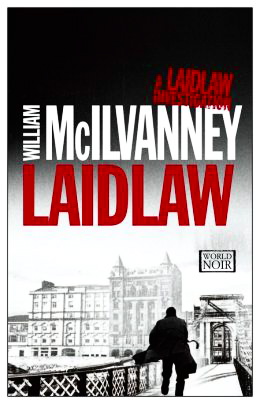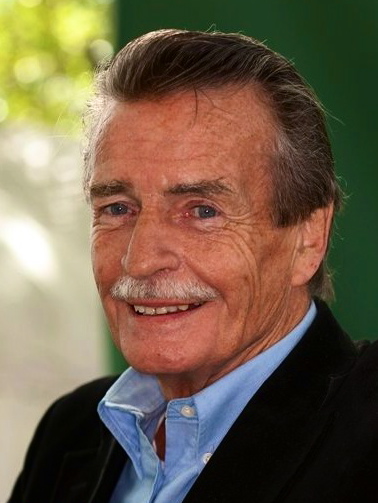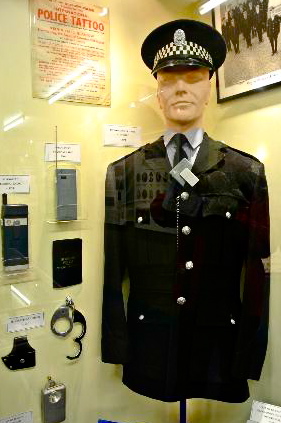Note: This novel was WINNER of the Crime Writers’ Association Macallan Silver Dagger Award for 1977. In 2013, the author was WINNER of both the Saltire Society Fletcher of Saltoun Award for his “outstanding contribution to Scotland’s life and culture,” and WINNER of the Glenfiddich Spirit of Scotland Award for Writing.
“[Laidlaw] felt his nature anew as a wrack of paradox. He was potentially a violent man who hated violence, a believer in fidelity who was unfaithful, an active man who longed for understanding. He was tempted to unlock the drawer in his desk where he kept Kierkegaard, Camus, and Unamuno, like caches of alcohol. Instead, he…tidied the papers on his desk. He knew nothing to do but inhabit the paradoxes.”
 In this classic novel from 1977, Scottish author/poet William McIlvanney pulls out all the literary stops, creating a novel so filled with ideas, unique descriptions, and unusual characters that labeling it as one of the great crime novels does it a disservice. It is also a literary novel of stunning originality, so unusual for its time that it is now labeled as the first of the “Tartan noir” novels, with McIlvanney himself described as the “Scottish Camus.”* Two sequels – The Papers of Tony Veitch (1983), a Silver Dagger Award winner, and Strange Loyalties (1991), a winner of the Scottish Art Council Award – complete the story of Laidlaw. Despite his success and his prizes, however, McIlvanney’s “Tartan noir” career ended after these three novels, with the author concentrating instead on his poetry, literary fiction, screenplays, journalism, and essays – and winning prizes for his work in all of these genres. Inexplicably, considering the author’s successes and his prizes, all three of the Laidlaw novels have been long out of print – until this year – when Europa Editions in the US and Canongate Books in the UK decided to republish Laidlaw. They are also planning the release of the two remaining books in the Laidlaw Trilogy for the fall of 2014.
In this classic novel from 1977, Scottish author/poet William McIlvanney pulls out all the literary stops, creating a novel so filled with ideas, unique descriptions, and unusual characters that labeling it as one of the great crime novels does it a disservice. It is also a literary novel of stunning originality, so unusual for its time that it is now labeled as the first of the “Tartan noir” novels, with McIlvanney himself described as the “Scottish Camus.”* Two sequels – The Papers of Tony Veitch (1983), a Silver Dagger Award winner, and Strange Loyalties (1991), a winner of the Scottish Art Council Award – complete the story of Laidlaw. Despite his success and his prizes, however, McIlvanney’s “Tartan noir” career ended after these three novels, with the author concentrating instead on his poetry, literary fiction, screenplays, journalism, and essays – and winning prizes for his work in all of these genres. Inexplicably, considering the author’s successes and his prizes, all three of the Laidlaw novels have been long out of print – until this year – when Europa Editions in the US and Canongate Books in the UK decided to republish Laidlaw. They are also planning the release of the two remaining books in the Laidlaw Trilogy for the fall of 2014.
The Prologue establishes the unique nature of this novel, with an unnamed young man running, running, totally in tune with his senses – “the lights of passing cars batted your eyeballs. Your arms came up unevenly in front of you, reaching from nowhere….It was like the hands of a lot of people drowning.” Most remarkably, however, the young man cannot understand what it is that he has done or why. He just knows that he has to run. “Half-an-hour before it, you had laughed. Then your hands were an ambush. They betrayed you…Your hands, that lifted cups and held coins and waved, were suddenly a riot, a brief raging. The consequence was forever.” He realizes now that his body is “a strange place,” and he wonders, “Out of what burrows in you had the creatures come that used you? They came from nowhere that you knew about.” He must be a monster, he concludes, believing that “nowhere in all the city could there be anyone to understand what you had done, to share it with you. No one, no one.”
As the novel itself begins, Detective Inspector Laidlaw of the Glasgow Crime Squad sits at his desk, and he is thinking some of the same things that the running man has been thinking. Even as a child, “He [experienced] nights when the terror of darkness had driven him to his parents’ room. He must have run for miles on that bed. It wouldn’t have surprised him if his mother had had to get the sheets re-soled. Then, it had been bats and bears…Now the monsters were simultaneously less exotic and less avoidable.” Laidlaw will be the detective who is most attuned to finding Tommy Bryson, the young “running man” who has killed a young woman, and these two opening scenes set up the reader for a dramatic and unusual novel of pursuit in which two men, one a killer and one a policeman, reveal themselves to be not so different from each other after all. Laidlaw is an outsider among the police, partly because he is regarded as a softie regarding criminals. One hard-headed police officer tells Laidlaw’s new partner, Det. Constable Brian Harkness, that “you’ll have to wear wellies when you work with [Laidlaw]. To wade through the tears. He thinks criminals are underprivileged. He’s not a detective. He’s a shop steward for neds.”
Soon the reader learns more about the killer’s background and the name of at least one friend who is willing to do whatever is necessary to save him, and as the search for the killer develops, the city of Glasgow is revealed in all its unsavory layers, from petty crooks to bookmakers to mob leaders. The reader meets them all, while simultaneously learning their loyalties and animosities. The police, too, have their hierarchy, and their own unsavory histories, and everyone’s motivation for finding Tommy differs. One person loves Tommy Bryson, while another has a murderous rage at him. One person wants to kill him in order to gain money from a mob leader, another plays two sides against each other as each side wants Tommy dead. One policeman wants to catch him in order to advance his career, and another wants to embarrass Laidlaw. The variations are limitless.

Ol Tolbooth, “a kind of midget tower with a small balustrade at the top and above that the figure of a unicorn and motto, “Nemo me lacessit.”
While none of these motivations are new, McIlvanney’s descriptive powers make the narrative feel new, filled with unique observations. One man is described as “a mobile quarrel with the world…His face looked like an argument you couldn’t win,” another as “Mary Poppins with hair on her chest.” Still another (years before Donald Trump) had “parted his hair just slightly above his armpits and trained the strands to climb like clematis.” Even something as commonplace as an early summer day becomes unique in McIlvanney’s hands. The Glasgow sun is “dully luminous, an eye with cataract.” People in the park are “pretending it was warm, exercising that necessary Scottish thrift with weather which hoards every good day in the hope of some year amassing a summer.”
As the novel works its way to the inevitable confrontation and climax, the reader (this one, anyway) continues to be enthralled by the author’s style and obvious literary skill, confident that the ending will be as perceptive and sensitive as the opening. Though we never really get to know Laidlaw as much as we might want, it helps to know that there are two more Laidlaw books coming out this fall. This one is a true classic for anyone who wonders just how good a crime novel can be, as Laidlaw holds to his own truths and refuses to succumb to the easy black and white view of the world so common to this genre.
*Source: http://en.wikipedia.org/
ALSO by William McIlvanney: THE PAPERS OF TONY VEITCH and STRANGE LOYALTIES
Photos, in order: The author’s photo by Ivon Bartholomew appears on http://www.bbc.co.uk
The uniform of the Glasgow police in 1977 is from http://www.bbc.co.uk/
Kelvingrove Park, where Jennifer Lawson’s body was found, is seen on http://www.visitscotland.com/
The Ol Tolbooth, shown on a website for which Liz Smith is webmaster, has the motto “Nemo me impune lacessit, meaning “No one assails me with impunity,” which Laidlaw interprets as “‘Visitors are advised not to be cheeky.” He likes the “civic honesty” of that. http://www.mycityglasgow.co.uk/
ARC: Europa Editions



